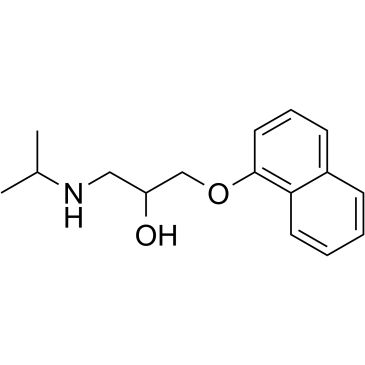Propranolol |
| Katalog-Nr.GC36980 |
Propranolol ist ein nichtselektiver β-adrenerger Rezeptor (βAR) Antagonist, der eine hohe Affinität für den β1AR und β2AR mit Ki-Werten von 1,8 nM bzw. 0,8 nM aufweist.
Products are for research use only. Not for human use. We do not sell to patients.

Cas No.: 525-66-6
Sample solution is provided at 25 µL, 10mM.
Propranolol is a non-selective β-adrenergic receptor (βAR) antagonist, exhibiting high affinity for both β1AR and β2AR, with Ki values of 1.8 nM and 0.8 nM, respectively[1]. It inhibits the binding of [3H]-DHA to rat brain membrane preparations with an IC50 of 12 nM[2]. Propranolol is used in research related to hypertension, pheochromocytoma, myocardial infarction, arrhythmias, angina, and hypertrophic cardiomyopathy[3].
In vitro, propranolol increases total ERK1/2 levels in a dose-dependent manner within the concentration range of 10-7 M to 10-3 M, after 24 and 48 hours of treatment, and specifically activates ERK1/2 at a concentration of 10-5 M[4]. After 24 hours of treatment at a concentration of 10-4 M, and after 48 hours at 10-9 M, propranolol significantly reduces the proliferation of HemSC cells[4]. Moreover, propranolol treatment at concentrations ranging from 50µM to 200µM for 24 hours increases the number of Annexin V-positive HemSCs, activates caspase-3, thereby rapidly inducing apoptosis in HemSC cells[4].
In vivo, propranolol (40 mg/kg/d, p.o.) significantly reduces the diameter and blood flow of vessels in an infantile hemangioma (IH) mouse model, while also promoting the activation of ERK1/2 within IH cells[4]. In the Tg2576 Alzheimer's disease transgenic mouse model, propranolol (5mg/kg/d, i.p.) is able to improve cognitive deficits demonstrated in novel object recognition and fear conditioning tests, reduce the increase in Aβ42 levels in the hippocampus, increase in Akt phosphorylation, and excessive phosphorylation of Tau[5].
References:
[1] Galandrin S, et al. Distinct signaling profiles of beta1 and beta2 adrenergic receptor ligands toward adenylyl cyclase and mitogen-activated protein kinase reveals the pluridimensionality of efficacy. Mol Pharmacol. 2006 Nov;70(5):1575-84.
[2] Briley M, et al. Evidence against beta-adrenoceptor blocking activity of diltiazem, a drug with calcium antagonist properties. Br J Pharmacol. 1980 Aug;69(4):669-73.
[3] Al-Majed AA, et al. Propranolol. Profiles Drug Subst Excip Relat Methodol. 2017;42:287-338.
[4] Munabi NC, et al. Propranolol Targets Hemangioma Stem Cells via cAMP and Mitogen-Activated Protein Kinase Regulation. Stem Cells Transl Med. 2016 Jan;5(1):45-55.
[5] Marta D , Gorka G ,RamÍrez MarÍa J. Propranolol reduces cognitive deficits, amyloid and tau pathology in Alzheimer's transgenic mice[J]. Int J Neuropsychopharmacol, 2013(10): 2245-2257.
Average Rating: 5 (Based on Reviews and 10 reference(s) in Google Scholar.)
GLPBIO products are for RESEARCH USE ONLY. Please make sure your review or question is research based.
Required fields are marked with *




















